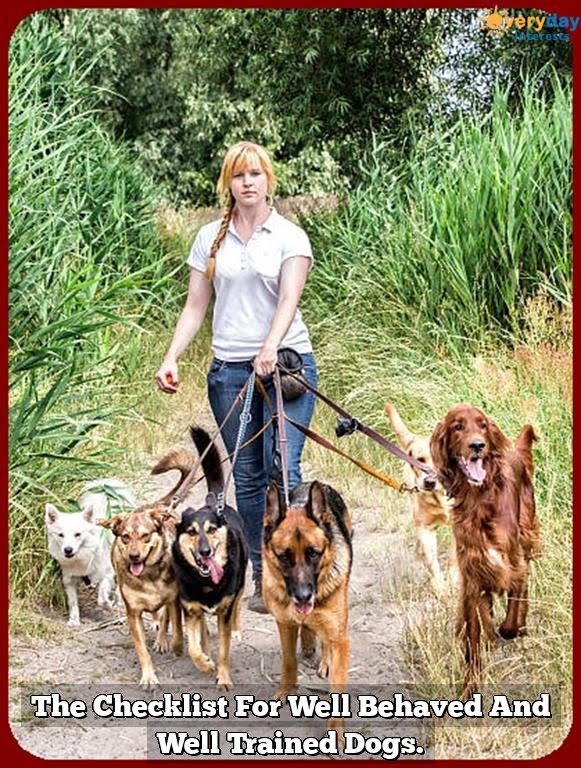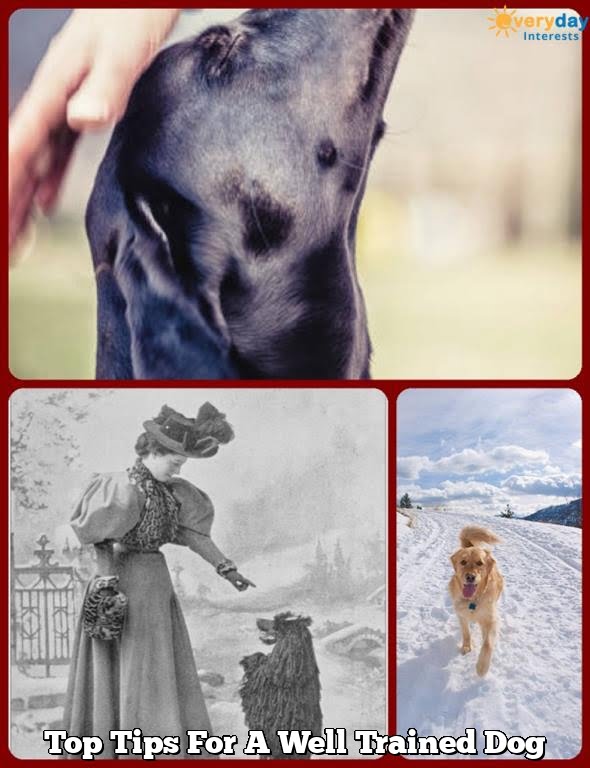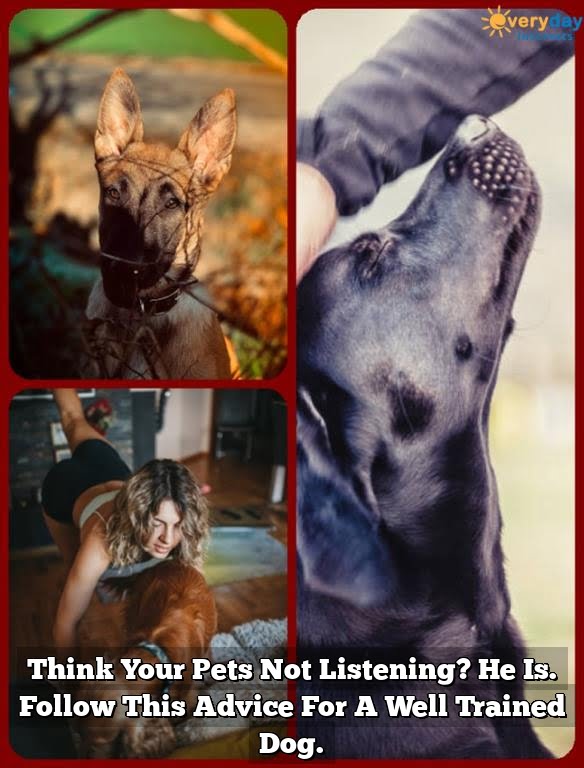Are you wondering how to get a well trained dog? Training your furry friend is not only beneficial for their behavior, but also for their overall well-being. In this article, we will explore the importance of training and provide valuable tips on how to achieve successful results.
It’s no secret that a well-trained dog makes for a happier and more harmonious household. In order to achieve this, it’s crucial to understand why training is essential for your canine companion. Whether you have a new puppy or an adult dog, proper training not only establishes good behavior, but also helps to strengthen the bond between you and your pet.
Choosing the right training method is key in achieving success with your dog. From positive reinforcement techniques to incorporating training into your daily routine, there are various methods that can be effective for different types of dogs. By setting clear and consistent rules and boundaries, you can ensure that your dog understands what is expected of them and what behaviors are acceptable. Understanding the importance of these foundational aspects will set the stage for successful training in the long run.
Choosing the Right Training Method for Your Dog
When it comes to choosing the right training method for your dog, it is important to consider your dog’s breed, temperament, and individual personality. Different dogs may respond better to certain types of training, so it’s essential to do your research and possibly consult with a professional trainer to determine the best approach for your furry friend.
One popular training method is positive reinforcement, which involves rewarding good behavior with treats, praise, or toys. This method focuses on encouraging and reinforcing desirable actions rather than punishing unwanted behaviors. Positive reinforcement has been proven to be effective in training dogs and also helps to build a strong bond between you and your pet.
Another approach is using clicker training, where a small handheld device makes a clicking sound to signal that the dog has performed a desired behavior. This method can be highly effective in teaching new commands and tricks and is especially useful for dogs who are easily motivated by food rewards.
It’s important to keep in mind that every dog is unique, so being open to trying different methods and being patient while finding what works best for your dog is key. What works for one dog may not work for another, so being flexible and adaptable in your approach will ultimately lead to successful training and a well-behaved pet.
Setting Clear and Consistent Rules and Boundaries
When training your dog, one of the most important aspects is setting clear and consistent rules and boundaries. Dogs thrive in an environment where they understand what is expected of them, and consistency is key to their learning process.
This means that everyone in the household should be on the same page when it comes to the rules and boundaries set for the dog. For example, if jumping on furniture is not allowed, then every member of the family should enforce this rule consistently.
Consistency also applies to the commands you use during training. If you use “down” as a command for your dog to lay down, then everyone involved in the training should use the same word. Using different words or phrases for the same command can confuse your pet and hinder their progress in learning.
In addition, setting clear rules means establishing boundaries within which your dog can behave freely. This could mean designating certain areas of the house as off-limits or teaching your pet to wait before entering or exiting doors. By creating a clear understanding of what behaviors are acceptable and what aren’t, you are effectively communicating with your dog and promoting a harmonious relationship based on mutual respect.
| Aspect | Description |
|---|---|
| Consistent Enforcement | Everyone in the household should enforce rules consistently. |
| Uniform Commands | Using consistent words for commands for all trainers involved. |
| Establishing Boundaries | Creatings clear understanding of acceptable behaviors & limits. |
Positive Reinforcement Techniques for Training
Positive reinforcement is an effective method for training a well-behaved dog. This technique involves rewarding your dog with treats, praise, or toys when they exhibit the desired behavior. The use of positive reinforcement helps to motivate your dog and encourages them to repeat the behavior in the future. This method is based on the principle that by rewarding good behavior, you can increase the likelihood of it being repeated.
When implementing positive reinforcement, it is important to ensure that the reward is given immediately after the desired behavior occurs. This helps your dog make a clear connection between their action and the reward they receive. Consistency is also key when using positive reinforcement techniques. By consistently rewarding the desired behavior, your dog will learn and understand what is expected of them.
One example of a positive reinforcement technique is clicker training, where a small device called a clicker is used to mark the moment when your dog performs a wanted behavior. The sound of the clicker is then followed by a treat or praise, which reinforces the behavior. Positive reinforcement techniques are not only effective but also contribute to building a strong bond between you and your dog.
| Positive Reinforcement Technique | Description |
|---|---|
| Clicker Training | A training method that uses a clicker to mark desired behaviors. |
| Treats and Praise | Rewarding good behavior with food treats or verbal praise. |
| Toy Rewards | Using toys as rewards for desirable actions during training sessions. |
Patience and Persistence
Training a dog requires patience and persistence, as it is a process that takes time and consistent effort. Whether you are teaching basic commands or addressing behavior issues, patience and persistence are crucial for successful training.
Understanding the Learning Process
Dogs, like humans, learn at their own pace. It’s important to understand that some dogs may pick up commands quickly, while others may need more time to grasp the concept. Being patient with your dog’s learning process is essential in creating a positive training experience for both you and your furry companion.
Consistency in Training
Consistency is key when it comes to training your dog. This means using the same commands, gestures, and rewards every time you work with your dog. Dogs thrive on routine and consistency, so being persistent in your training methods will help reinforce their understanding of what is expected of them.
Managing Frustration
It’s natural to feel frustrated when your dog doesn’t seem to be catching on to a command or behavior modification as quickly as you would like. However, it’s important to manage your frustration and remain calm during training sessions. Dogs can sense when their owners are agitated, which can hinder the learning process. Taking a break and approaching the training session with a clear mind will benefit both you and your dog.
By practicing patience and persistence in your training efforts, you will establish a strong foundation for successful obedience and behavior with your dog. Recognizing that training takes time and consistency will ultimately lead to a well-trained and well-behaved pet that brings joy and companionship into your life.
Incorporating Training Into Daily Routine
Consistency Is the Key
When it comes to training your dog, consistency is crucial for success. It’s important to incorporate training into your daily routine in order to reinforce the lessons learned and ensure that your dog retains what they have been taught. This means setting aside specific times each day for training sessions, as well as integrating training into everyday activities such as walks, feeding time, and playtime.
Integrating Training With Everyday Tasks
One way to make training a part of your daily routine is by integrating it with everyday tasks. For example, you can use meal times as an opportunity to practice obedience commands such as “sit” and “stay”. You can also incorporate training into walks by practicing loose-leash walking and working on recall commands. By making training a part of your daily activities, you can help reinforce good behavior and ensure that your dog continues to improve their skills.
Making Training Fun and Engaging
Incorporating training into your daily routine doesn’t have to feel like a chore – it can be an enjoyable experience for both you and your dog. Make training sessions fun and engaging by using positive reinforcement techniques, incorporating games and interactive toys, and varying the types of exercises you do. By keeping training sessions interesting and rewarding, you can help keep your dog motivated and eager to learn.
By incorporating training into your daily routine in these ways, you can help ensure that your dog receives consistent reinforcement of their training and continues to progress in their skills. This approach also allows you to build a strong bond with your pet through regular interaction and shared activities.
Addressing Common Behavior Issues Through Training
When it comes to training your dog, it’s important to address common behavior issues that may arise. Understanding how to handle these issues can make the training process smoother and more effective.
Here are some common behavior issues and ways to address them through training:
- Jumping: If your dog tends to jump on people when they come into the house, you can teach them the “off” command using positive reinforcement. Consistently rewarding your dog when they keep all four paws on the ground will help reinforce this desired behavior.
- Barking: Excessive barking can be a nuisance, but with consistent training, you can teach your dog the “quiet” command. Using positive reinforcement techniques, such as rewarding your dog when they stop barking on command, can help reduce this behavior.
- Pulling on the leash: Many dogs have a tendency to pull on the leash during walks. Training your dog to walk calmly on a leash can be achieved through consistent practice and positive reinforcement. Rewarding your dog for walking by your side without pulling can help reinforce this behavior.
By addressing these common behavior issues through training and using positive reinforcement techniques, you can effectively correct these behaviors and build a strong bond with your well-trained dog. Remember that patience and persistence are key elements for successful training, so be consistent and celebrate each achievement along the way.
Seeking Professional Help When Needed
When it comes to training your dog, there may be instances where seeking professional help is necessary. Whether your dog is exhibiting aggressive behavior, experiencing severe anxiety, or simply not responding to your training efforts, a professional dog trainer or behaviorist can provide the expertise and guidance needed to address these issues.
Professional dog trainers have extensive knowledge and experience in dealing with various behavioral problems in dogs. They are equipped with effective techniques and methods that can help modify your dog’s behavior and improve their overall obedience. Additionally, they can offer personalized training plans tailored to your dog’s specific needs and temperament.
In some cases, seeking professional help may also be necessary for the safety of both you and your dog. Aggressive behavior in dogs can pose a threat to the people around them, as well as other pets. A professional trainer can assess the underlying causes of this aggression and implement strategies to manage and correct it effectively. It’s important to address such issues promptly and responsibly by consulting with a professional.
Ultimately, seeking professional help when needed demonstrates a commitment to your dog’s well-being and overall success in training. It shows that you are willing to go the extra mile to ensure that your dog receives the best possible care and guidance for their behavioral development. With the assistance of a skilled trainer or behaviorist, you can work towards creating a safe, harmonious environment for both you and your furry companion.
Maintaining Consistent Training for Long-Term Success
Consistency is key when it comes to training your dog. Once you have established the rules and boundaries, it is important to maintain a consistent approach in enforcing them. This includes using the same commands, gestures, and rewards every time you train your dog. Consistency will help your dog understand what is expected of them and reinforce the desired behavior.
To maintain consistent training for long-term success, consider incorporating the following strategies:
- Schedule regular training sessions: Set aside dedicated time each day for training sessions with your dog. Consistency in practicing commands and behaviors will help reinforce their training and prevent any backsliding.
- Be persistent: It’s normal for dogs to test boundaries or try to revert to old habits. Stay persistent in enforcing the rules and continue to use positive reinforcement techniques to encourage good behavior.
- Seek ongoing education: As a responsible pet owner, it’s important to stay informed about new training techniques, behavioral issues, and how to address them effectively. Attend workshops, read books on canine behavior, or seek advice from professional trainers to keep improving your training skills.
Remember that maintaining consistent training requires commitment from both you and your dog. Over time, you will see the benefits of this dedication as you build a strong bond with your well-trained pet.
Celebrating Achievements and Building a Strong Bond With Your Well-Trained Dog
In conclusion, celebrating the achievements of your well-trained dog is a crucial part of the training process. Not only does it serve as positive reinforcement for your pet, but it also strengthens the bond between you and your furry companion.
Whether it’s mastering a new trick, overcoming a behavioral issue, or simply displaying good behavior, taking the time to acknowledge and celebrate these milestones will go a long way in reinforcing the training and creating a happy, healthy relationship with your dog.
Building a strong bond with your well-trained dog also involves spending quality time together. Engaging in activities such as regular walks, playtime, and grooming not only provides physical exercise and stimulation for your pet but also deepens the connection between you. This strong bond will make further training easier and more effective as your dog learns to trust and respect you as their leader.
Ultimately, getting a well-trained dog requires commitment, patience, and consistency from the owner. By understanding the importance of training, choosing the right method and being persistent with clear rules and boundaries, you can set your dog up for success.
Seeking professional help when needed and incorporating training into your daily routine will ensure that your furry friend continues to display good behavior in the long run. With positive reinforcement techniques and lots of love and care, celebrating achievements along the way will lead to a well-trained dog who is not only obedient but also a loyal and cherished member of the family.
Frequently Asked Questions
How Do You Make a Well Trained Dog?
Making a well-trained dog starts with establishing clear boundaries, consistent training, and positive reinforcement. It’s important to establish yourself as the pack leader through calm-assertive energy and to use training techniques that are appropriate for your dog’s breed, age, and temperament.
How Long Does It Take to Get a Well Trained Dog?
The time it takes to get a well-trained dog can vary depending on the individual dog and the owner’s consistency in training. While some dogs may respond quickly to training and become well-behaved in a matter of months, others may take longer due to their personality or past experiences.
In general, however, it’s important for owners to be patient and dedicated to the training process.
What Is Considered a Well Trained Dog?
A well-trained dog is one that responds to basic commands such as sit, stay, come, and down reliably. They also exhibit good behavior in various situations such as walking on a leash without pulling, greeting people politely, and being calm around distractions.
Additionally, a well-trained dog is one that respects their owner as the leader and is able to socialize appropriately with other dogs and people.

Welcome to the blog! I am a professional dog trainer and have been working with dogs for many years. In this blog, I will be discussing various topics related to dog training, including tips, tricks, and advice. I hope you find this information helpful and informative. Thanks for reading!





